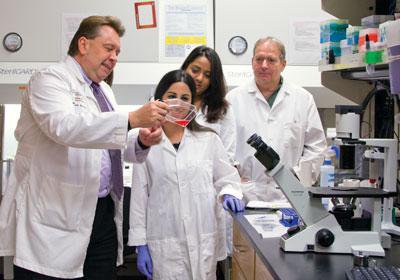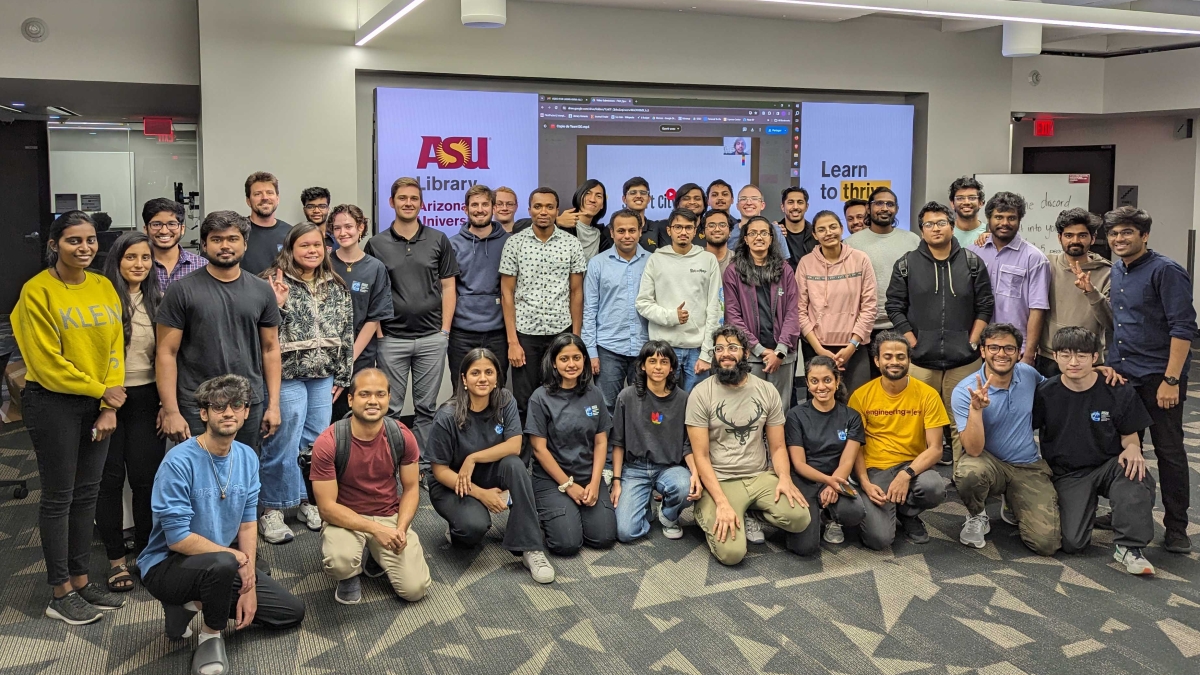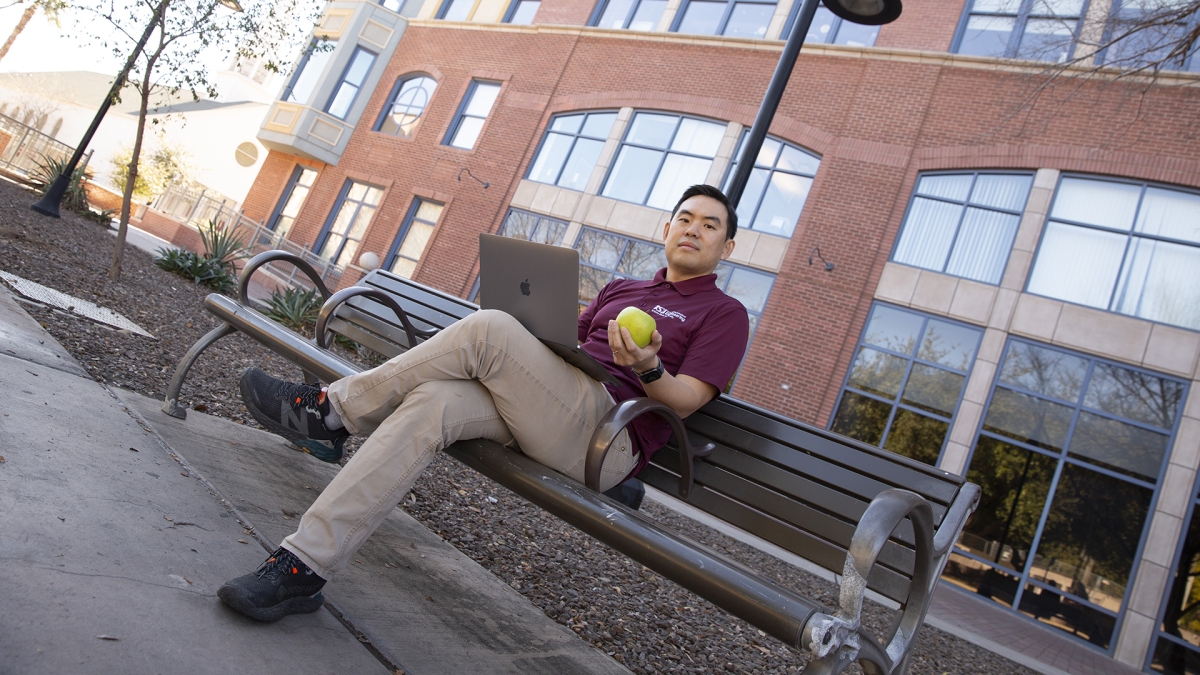NCUIRE program leads to vitamin D study, sets student's course
Undergraduate research program at ASU's West campus helps Marya Sabir find her calling as a research scientist

It’s a commonly held belief that college is where you “find yourself,” whether that means realizing a passion for the arts or discovering a hidden talent for mastering equations. Still, many students set out with a plan already in mind.
That was the case for Marya Sabir. She entered her freshman year at Arizona State University's New College for Interdisciplinary Arts and Sciences with a one-track mind: medical school or bust. Then, as the year came to a close, a friend recommended trying out some research with a professor whose lab was known at the West campus for encouraging undergraduate study.
Sabir contacted the professor, Peter Jurutka, with the School of Mathematical and Natural Sciences. He laid it all out for her, including the two-year commitment stipulation. His molecular endocrinology lab, which looks at how nutrients affect our overall health and aging, sounded interesting.
“So I accepted, not really knowing really what I was getting into,” Sabir said.
The excitement of hands-on research
Soon, she was hooked. Fascinated by the subject matter and buoyed by Jurutka’s encouragement, she decided to make a more permanent commitment, applying to the New College Undergraduate Inquiry and Research Experiences (NCUIRE) Program.
“I found myself staying in the lab until 2 a.m. working on projects, trying to get every little detail right. Before that, I didn’t even consider research a field that I might go into,” she said.
Founded in 2011 by Todd Sandrin, West campus vice provost and dean of New College, NCUIRE provides undergraduates with the opportunity to engage in meaningful research partnerships with faculty and each other, across all disciplines.
Sabir found great value in the faculty-student research collaboration model.
“It was an amazing experience,” she said. “Dr. Jurutka is a great mentor. He gives you a level of independence to come up with your own ideas and troubleshoot on your own, like a real scientist would.”
The appreciation, it appears, is mutual.
“It is extremely rewarding, both personally and professionally, to engage students via intellectual discovery, and to pass on not only an academic knowledge base, but also the tools that my students will use to access new discoveries and ask novel questions in their role as lifelong learners,” Jurutka said.

Professor Peter Jurutka (far left) and ASU biochemistry alum Marya Sabir (center) in his lab on ASU's West campus. Photo courtesy Phoenix Magazine
Sabir graduated from ASU in 2015 with a degree in biochemistry and is currently conducting neurogeneticNeurogenetics studies the role of genetics in the development and function of the nervous system. research on atypical Parkinson’s disease cases at the National Institutes of Health.
During her tenure in Jurutka’s lab, she received numerous undergraduate fellowships and scholarships to conduct research, as well as poster presentation awards and travel awards to attend national conferences.
That’s pretty typical of NCUIRE students, who have a 97 percent year-to-year retention rate. They also publish alongside world-class faculty in top-tier journals — Sabir included. In addition to serving as a co-author on multiple peer-reviewed manuscripts and book chapters, she served as the lead author on a study published in the Journal of Steroid Biochemistry and Molecular Biology in September 2017.
Turning a degree into a career
The study, conducted during her time in Jurutka’s lab at ASU, used kidney and bone cells derived from animal models to alter their gene expression, essentially testing what factors made vitamin D receptors more active, thereby leading to increased health benefits.
Vitamin D is linked notably to bone health but also a number of other factors we are still discovering, including the immune system, small intestine, colon, heart, cognitive function and longevity.
“There’s so much that vitamin D affects, we still don’t know the extent of it,” Sabir said. Her goal with the study was to try to illuminate more of what we don’t know.
What she and her team found was that the presence of a certain enzyme increased activity in vitamin D receptors, providing a missing piece in the puzzle of which molecular mechanisms are important in anti-aging, as well as cancer prevention.
“There is a unique satisfaction that arises from learning a scientific concept in a textbook and then having the ability to go into the laboratory to actively study the described phenomena that is immensely gratifying,” Sabir said.
She still contributes to research in Jurutka’s lab and has plans to enter into a dual master’s-doctoral degree program, with hopes of becoming a physician-scientist, conducting interdisciplinary and collaborative research in the field of neuroscience.
For Sabir, the opportunity to engage in research as an undergraduate at ASU was paramount in determining the course of her future, enabling her to “hone marketable aptitudes such as teamwork, interdisciplinary thinking and problem solving, and written/oral communication.”
“As an undergraduate student at ASU, I was prepared in the classroom to think critically and hone my problem-solving aptitudes that were then exponentially amplified in Dr. Jurutka’s molecular endocrinology research program,” she said. “Through Barrett, the Honors College and NCUIRE programs, the extensive resources at ASU allowed me to connect textbook learning to practical applications in the biomedical field while making meaningful contributions to the enterprise at large.”
Top photo: ASU biochemistry alum Marya Sabir arranges vials in Professor Peter Jurutka's molecular endocrinology lab on ASU's West campus. Photo courtesy of Marya Sabir
More Science and technology

SpaceHACK highlights student solutions to environmental challenges, digital divide
By Adrianna Nine About 250 students from around the world convened online and at Arizona State University on March 22 for the ASU Interplanetary Initiative’s second annual SpaceHACK for…

New AI for a new era of discovery
As the legend goes, in 1665, Sir Isaac Newton sat in his garden at Woolsthorpe Manor in England and looked on as a lone apple dropped from a tree branch, falling straight down. This chance encounter…

ASU receives 3 awards for research critical to national security
Three researchers in the Ira A. Fulton Schools of Engineering at Arizona State University have received grant awards under the Defense Established Program to Stimulate Competitive Research, or…